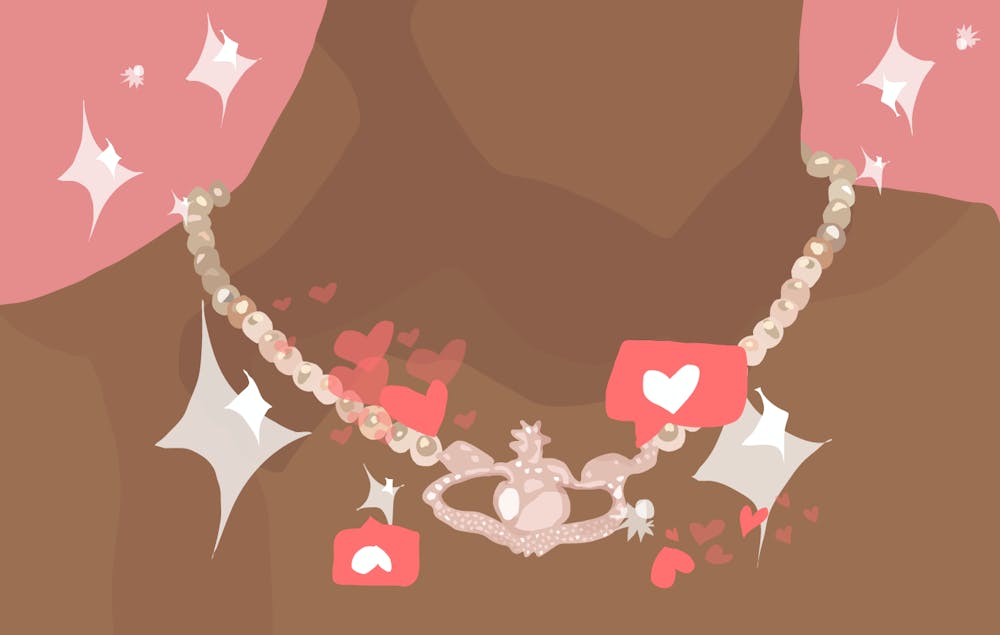The pearl necklace has always been a timeless piece of jewelry. Pearls often evoke super–polished and glammed up images of Audrey Hepburn or Grace Kelly, but the modern interpretation of the pearl necklace isn’t so prim and proper. From TikTokers like Ellie Zeiler and Vinnie Hacker to full–fledged supermodels like Bella Hadid, to seemingly every single girl on Instagram, everyone is wearing the Vivienne Westwood Mini Bas Relief Choker. With its delicate string of faux pearls and an orb charm, the choker has become a must–have in any self–professed fashion fanatic’s jewelry collection.
However, Vivienne Westwood has been making waves in the fashion industry long before the choker even existed. She first gained notoriety as a designer, not in the mainstream, but as part of the punk and New Wave fashion movements in the 1970s and 1980s by creating clothing designed to provoke social and political change. In the early 1970s, Westwood and her boyfriend at the time, Malcolm McLaren, set up shop in London, which members of the punk scene would often use as a meeting place. Sex, the name of the store which Westwood finally settled on in 1974, was filled with leather, latex, and fetishwear.
This rebellious spirit underlies many of her collections, and she often combines punk symbolism with traditional feminine aesthetics. Westwood is often credited as one of the pioneers of British punk fashion, using tartans and bright pops of color to revolt against the establishment.
While Westwood’s designs were popular with punk youth and those in the music world, she only achieved mainstream success in 1981 with the release of her first collection, the Pirate Collection. The collection was both a critical and commercial success, with the British public praising Westwood for her praising Westwood for her clothing, which was inspired by the British aristocracy but maintained hints of anarchy.
By the 1990s, Westwood’s signature style was established as she married traditional British fashion with a French sense of proportion, creating designs that were equally polished yet outrageous. Inspired by the 18th century, Westwood began to incorporate corsets into her collections, using them as pieces of outerwear instead of underwear, thus recalling her sex–inspired beginnings.
The brand first saw mainstream success during a 2019 revival backed by Gen Z when vintage Vivienne Westwood corsets were spotted on numerous celebrities such as FKA Twigs, Hailey Bieber, and Dua Lipa. However, due to the high prices of these vintage corsets, these pieces are hardly a reasonable purchase for the average consumer. With this celebrity exposure, Vivienne Westwood was quickly becoming the brand to wear among the younger generations.
Around the same time that Westwood put out the corset, she introduced the world to her signature pearl choker, an homage to the jewelry of royal women of the past with a contemporary flair. Westwood’s orb is the perfect representation of her brand: The recognizable emblem is the British Sovereign’s Orb surrounded by a ring of Saturn, which combines a piece of classic British regalia with astronomy—the perfect hybrid of the past and the future.
The juxtaposition of the new and the old is part of what made Westwood's designs so successful with younger audiences at the emergence of her career and how she is able to continue to find success with the same demographic today. In early 2020, the choker was spotted on two of today’s It Girls, Madison Beer and Bella Hadid. Paired with the rise of gold jewelry and pearl accents, this means that more and more people have begun to wear the necklace, specifically on TikTok, and by mid–2020, interest in the necklace had spiked astronomically.
The popularity of the necklace on social media showcases how Gen Z is able to take a notoriously exclusive style and reclaim it for the masses. It may not be rebellious or punk for everyone to be wearing the same jewelry, but to have the power to determine what is in trend most definitely is. The fact that the trend du jour is from a designer as defiant as Westwood makes its power that much greater. There can be honor in reviving pieces inspired by that past and sporting them in a modern day context.
TikTokers, Instagrammers, and influencers have all taken what is pivotal to the fashion industry—in–person advertising and interaction—and turned it on its head. They've learned how to exploit the temptation of trends via online platforms, creating an endless stream of thrifting hauls and "outfit of the day" content while also building a level of trust with their viewers. Without a doubt, the internet has helped shape trends and facilitate the spread of them.
The average teen on social media might order a Vivienne Westwood pearl orb necklace in an effort to look like that girl she saw on her feed or maybe even to emulate her favorite celebrity. But, unlike the punk customers of Westwood’s early days, Gen Z has a disruptive loyalty among themselves rather than with any particular brand. Their trends move too fast to dwell on any one designer for long.







